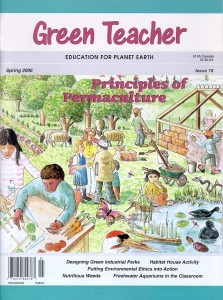Green Teacher 78, Spring 2006
Purchase this issue or subscribe
Features
A Permaculture School Garden by Patrick Praetorius
Applying the principles of a design methology called permaculture to school gardens and other projects helps to reinforce the values of resourcefulness, stewardship and sustainability. This article describes how Oak Grove School, in Ojai, California, applied the principles of permaculture to the creation of the school’s gardens, pond, straw bale greenhouse and outdoor seating area.
Ethics in Action: Adopting an Environmental Practice by John P. Engel and Daniel Sturgis
This environmental ethics assignment, adaptable to all grade levels, challenges students to align their behavior with environmental ethics, and in the process learn how much easier it is to change an old habit or adopt a new one than they thought
Leaving ‘Leave No Trace’ Behind: Towards a Holistic Land Use Ethic by David Moskowitz and Darcy Ottey
The authors question the notion that it is possible to live in the natural world without leaving a trace. They suggest we adopt Conscious Impact Living, a more holistic land use ethic that supports a stronger sense of connection with the natural world by recognizing that because humans live within nature, they will always have an impact on it.
Designing a Sustainable Industrial Park by Robert A. Sweeney and Phyllis A. Sweeney
This step-by-step exercise asks students to plan a “green” industrial park that generates its own energy, conserves and reuses materials, and minimizes waste. The exercise is adaptable for use with students from elementary grades through high school.
Tank Tips: A Freshwater Aquarium in the Classroom by Rebecca Holcombe
A freshwater aquarium in the classroom offers both aesthetic appeal and the opportunity to integrate learning across many disciplines. The article offers tips for selecting aquarium equipment and suitable freshwater tropical fish, and how to link an aquarium project to the curriculum in various subject areas.
Reading the Landscape by Janice Schnake Greene
The author shares teaching activities suitable for all age groups that help students become more aware of the natural world while still achieving required curriculum goals. Based on the writings of conservationist Aldo Leopold, the activities encourage students to learn the “stories of the land” through observation and inquiry.
Habitat House Hunt by Kristin Mack-Hammer and Janice Denney
In this activity for Grades 5-8, students play real estate agents who must find suitable homes for their urban animal clients. It is a fun way for students to learn about the importance of preserving wildlife habitats.
Field Trips: The Good, Bad and the Ugly by Lisa Woolf
One of the most common mistakes made by a classroom teacher when teaching outdoors is to forget to adapt the teaching techniques and structures used successfully in the classroom. This article recounts the story of a disastrous field trip, the lessons learned, and the steps taken to turn things around. It includes suggestions for making field trips meaningful learning experiences for students.
Glorious Weeds! by Jack Greene
The author shares ideas and activities designed to help students appreciate the value of common plants that are often dismissed as mere “weeds”
And as always, over 20 new educational resources are profiled and evaluated in this issue of Green Teacher.
Leave a Reply
You must be logged in to post a comment.






